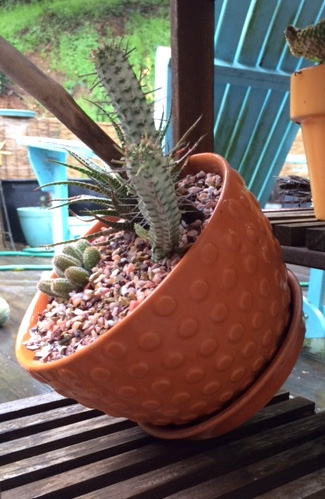
Right now most of that freshwater goodness goes into ditches and drains to the ocean. There are good reasons for this; when rainwater ponds, it may be targeted by mosquitoes looking to lay eggs. In addition to being annoying, mosquitoes can carry diseases. That's a main reason why county Mosquito Abatement personnel go around putting mosquito fish into ponds - so that fish will eat mosquito larvae.
Direct it away!
Water pooling around your foundation and plants is definitely not ideal. If plants sit with wet roots for too long, they can develop root and crown rot. Bacteria such as E. coli and Salmonella may be introduced to your produce if veggies are inundated for too long. If you have downspouts that direct rain from your roof, through gutters, and down to the ground, you can buy downspout extensions pretty inexpensively from big box stores. An extension can be hooked up quickly, even in the rain, to keep rain from collecting right by your house. But there's more you can do...
Collect and use it!
Rainwater catchment systems can range from 50 gal rain barrels to several thousand gallon cisterns. Rain barrels can be hooked up to catch water coming out your downspouts. The barrel often has a spout installed so that you can hook up a hose to water plants with the water. Usually the water is gravity-fed, so having the rain barrel up on blocks will allow you to get a little stronger flow through your hose. Downspout water can also be directed to above- or underground containers for storage. A pump is usually required, either to get water to the cistern or to get water out of it. Online resources for Santa Cruz and Monterey counties can help you find vendors who sell parts and companies that install systems. A rain barrel can be a relatively simple DIY project and googling 'rain barrel DIY' will provide plenty of tutorials and videos to build one for yourself. But there are still other alternatives...
Plant a rain garden!

- Downslope rainwater collection surface.
- Minimum 5-10 ft from structures.
- Not over a septic system.
- Not in a place that is already soggy.
- Ideally in full or partial sunlight.
Harvest water from your roof or driveway. Plant when the soil is dry, preferably fall. If your chosen spot has slow soil infiltration rates, soil can be amended to improve infiltration. Mulch your rain garden to prevent weed growth and be prepared for some maintenance as your rain garden is getting established. More information on building a rain garden can be found here, here, and here.
Appreciate the rainfall!
As you are watching all the lovely rain fall right now, don't forget that potted plants can get easily swamped. I put pots likely to drain poorly onto their sides or tilt them at an angle so they drain better. Look around your property to ensure there are not pots, garbage can lids, or other containers that will collect rainwater and allow mosquitos to breed. Check your downspouts to make sure that they are not directing water to your foundation. And then tuck yourself into your bed and listen to the sound of the raindrops on your roof.
Don't forget to subscribe to our blog so that you receive an email notification when a new post goes up. If you have questions, contact us online, by phone or in person to get answers to your gardening quandaries.